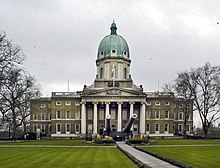|
Walcot Square
 Walcot Square is an 18th century garden triangle in Central London. The "square" is in the London Borough of Lambeth and has a very rare triangular shape. Since 1968 in planning policy it is a Conservation Area.[1] Three rows of houses front its communal green, granted Grade II listed status under the statutory protective and recognition scheme in 1981 (the mainstream and initial category).[2] Location and layout North of a double row of homes with gardens, Brook Street, is Geraldine Mary Harmsworth Park in which stand Imperial War Museum and two cafes (on the site of a mental-health hospital). To the south is St Mary's Gardens, to the west an avenue, Kennington Road, and east is West Square. The communal-green-centred street is in the SE11 postcode district. The nearest tube station is Lambeth North, 500 m north. The late Georgian three-storey terraced houses, forming its stock (some of which due to slightly raised-above subterranean-only level basements), surround a private 0.2-acre (0.081 ha) communal garden, owned and maintained by the Walcot Foundation. No №1 nor 64 exist; the highest of sets being the sole addition number, 68A, (on the evens sides of the estate) or 95 (odds side of the estate). HistoryThe street is named after Edmund Walcott, a haberdasher, who bequeathed the 30 acres (12 ha) on his death, in 1667, in trust for the poor of St. Mary, Lambeth, and St Olave's Church, Southwark.[3][4] Each of the three terraced sides differ slightly in design but are all constructed from stock brick and stucco which contributes to the modestly formal domestic scene. Notable features include stucco door surrounds, black painted doors, and long casement windows with ornamental anthemion cast iron balconette and railings. № s9–81 (odds) were built by John Woodward; 16–24 (evens) by Charles Newnham; and 26–50 (evens) by John Chapman. London BlitzAs with the rest of London, incendiary bombs hit some of the street in the London Blitz in World War II.[5] Where buildings were destroyed comparatively new ones were put up to match the originals.[6] Notable residents
Film and literature
References
External links |